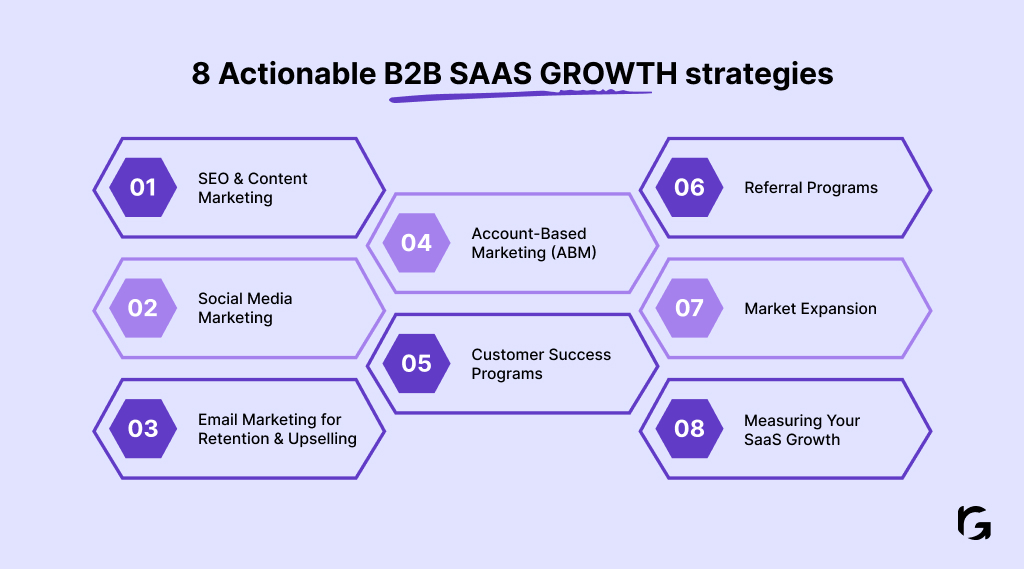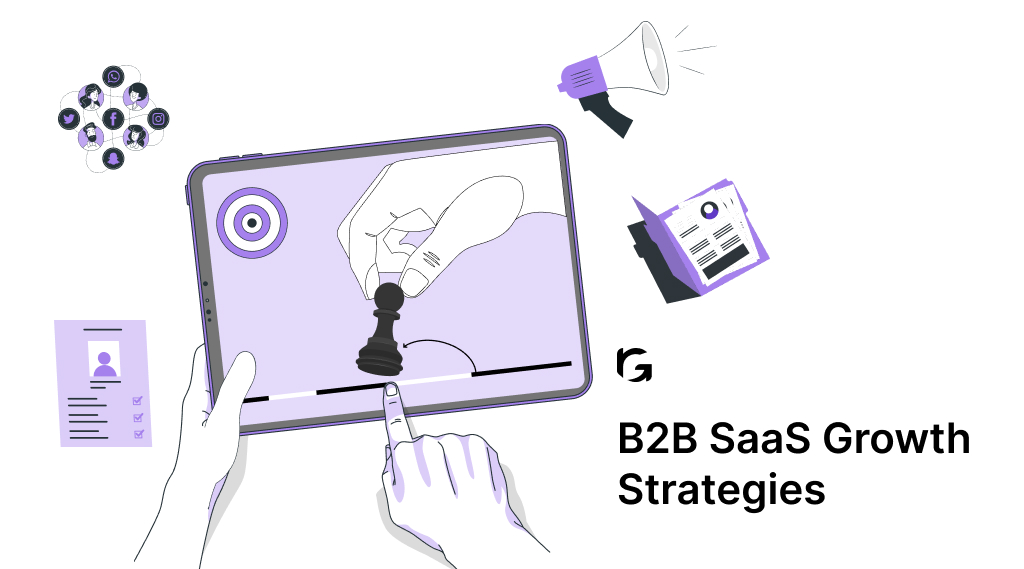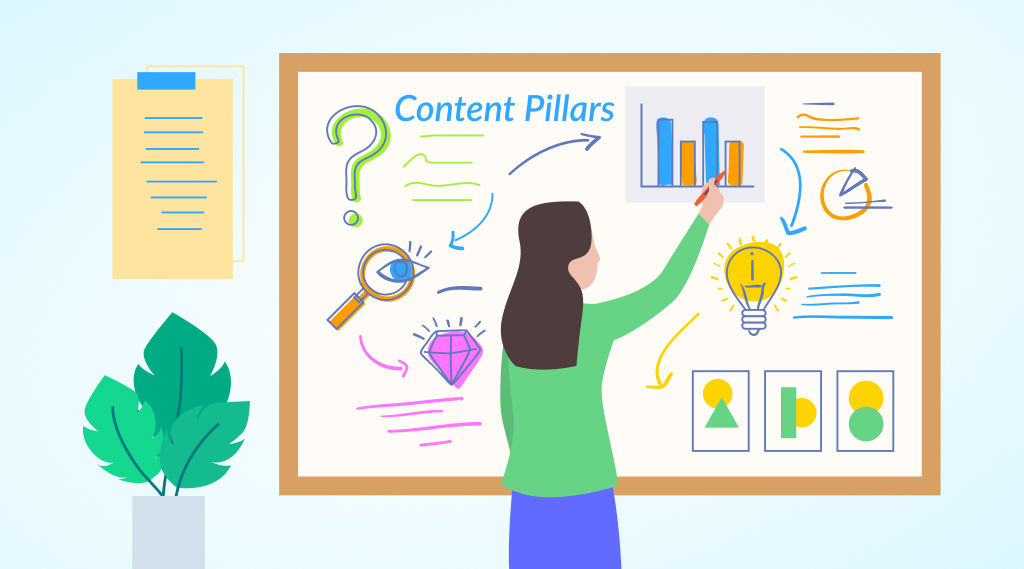Running a B2B SaaS business can be tough. Sometimes it’s great, sometimes it’s hard, and often it’s unpredictable. But here’s some good news: the B2B SaaS market is expected to grow from $197 billion in 2023 to $232 billion in 2024. That’s a big increase! The question is, how can you get a share of this growth? and what are some b2b growth strategy?
We’ve distilled nine high-impact strategies that drive measurable results in lead generation and sales. These aren’t just theories – they’re battle-tested tactics that have propelled our clients to new heights of success.
Why is SaaS growth so important?
Survival in a competitive market
The SaaS industry is packed with competitors and always changing. Without growth, you risk falling behind others, making it crucial to stay on top of market trends.
Financial stability
More customers and higher retention lead to increased revenue and profits. This growth ensures your business can reinvest and scale sustainably.
Investor attraction
If you’re aiming to secure funding or attract investors, consistent growth is a key factor they prioritize. Demonstrating strong growth signals your company’s long-term potential.
Market leadership
Growth allows you to secure a bigger market share, positioning your brand as a top player in your field. This dominance helps in building brand loyalty and expanding influence.
Driving innovation
Growth can provide the resources needed to invest in new products and ideas. With more capital, your company can stay ahead by continually improving and innovating.
Now that we’ve covered the basics, let’s roll up our sleeves and run through the strategies that can take your SaaS business to the next level.
8 Actionable B2B SaaS growth strategies to use in 2024
Companies like Slack and Zoom have thrived by making their products easy to adopt and share, turning users into advocates. Implement in-product prompts, onboarding tours, and freemium models to drive user engagement and accelerate growth.
By letting your product take center stage, you enable users to experience its value firsthand, leading to natural adoption and expansion:

1. SEO and content marketing
What it is?
This strategy involves creating valuable, product-focused content that’s optimized for search engines. It’s about being there when your potential customers are looking for solutions to their problems.
Why it’s important?
SEO and content marketing act like a 24/7 salesperson for your SaaS. When done right, it continuously attracts potential customers to your website, introduces them to your product, and guides them through the buyer’s journey.
How to implement it
- Keyword Research: Use tools like SEMrush, Ahrefs, or Google Keyword Planner to find keywords your target audience is searching for. Look for a mix of high-volume keywords and long-tail phrases that are relevant to your product.
- Create Problem-Solving Content: Develop blog posts, how-to guides, FAQs, and other content that directly addresses your audience’s pain points. Make sure each piece of content naturally leads the reader towards your product as a solution.
- Optimise Everything: From your website structure to individual blog posts, ensure everything is SEO-friendly. This includes optimising title tags, meta descriptions, headers, and image alt text.
- Build Quality Backlinks: Reach out to industry influencers, contribute guest posts to reputable sites, and create shareable content to earn backlinks that boost your SEO.
- Regular Content Updates: Keep your content fresh and up-to-date. Search engines favour websites that regularly publish new, relevant content.
Pro Tip: Don’t just create content for the sake of it. Each piece should serve a purpose in your overall marketing funnel, guiding readers towards trying your solution.
2. Social Media Marketing
What It Is?
This strategy involves engaging with your audience on social media platforms where they spend their time. It’s about building brand awareness, fostering community, and driving traffic to your website.
Why It’s Important?
Social media allows you to connect with your audience on a more personal level, showcase your brand personality, and stay top-of-mind with potential and existing customers.
How to Implement It?
- Choose Your Platforms Wisely: Focus on the platforms where your target audience is most active. For many B2C SaaS businesses, this often includes Facebook, Instagram, Twitter, and LinkedIn.
- Create Engaging Content: Share a mix of valuable tips, behind-the-scenes glimpses, user-generated content, and product updates. Use a variety of content formats like images, videos, and infographics to keep things interesting.
- Develop a Consistent Posting Schedule: Use social media management tools to plan and schedule your posts in advance, ensuring a consistent presence.
- Engage With Your Audience: Respond to comments, participate in discussions, and use social listening tools to join relevant conversations about your industry.
- Leverage Paid Social: Use targeted ads to reach potential customers who might be interested in your product. Experiment with different ad formats and audience targeting options.
Pro Tip: Don’t be afraid to show some personality on social media. Brands like Duolingo and Slack have mastered the art of engaging, often humorous content that keeps their audience coming back for more.
3. Email Marketing for Retention and Upselling
What It Is?
This strategy uses targeted email campaigns to keep current customers engaged, inform them about new features, and encourage them to upgrade their subscriptions.
Why It’s Important?
Email provides a direct line of communication to your customers. It’s perfect for nurturing relationships, increasing customer lifetime value, and reducing churn.
How to Implement It?
- Segment Your Email List: Group your customers based on their behaviour, preferences, and stage in the customer journey. This allows for more personalised and relevant communication.
- Create a Welcome Series: Develop a series of onboarding emails for new customers to help them get the most out of your product from day one.
- Personalise Your Emails: Use the customer’s name and tailor content to their specific needs and interests based on their usage patterns and preferences.
- Highlight New Features: Keep customers informed about product updates and how they can benefit from new features.
- Celebrate Milestones: Send emails marking anniversaries or achievements to foster loyalty and remind customers of the value they’re getting.
- Develop Re-engagement Campaigns: Create targeted campaigns to win back customers who haven’t used your product in a while.
Pro Tip: Always provide value in your emails. Whether it’s exclusive tips, early access to new features, or special offers, give your customers a reason to open and engage with your emails.
4. Account-Based Marketing (ABM)
What It Is?
This involves adapting B2B marketing principles to target high-value customer segments in B2C SaaS. It’s about personalising your marketing efforts for your most valuable customers or potential customers.
Why It’s Important?
ABM allows for hyper-personalised marketing, which can lead to higher conversion rates, increased customer satisfaction, and improved retention among your most valuable customers.
How to Implement It:
- Identify High-Value Segments: Analyse your customer data to identify users who frequently purchase, have a high lifetime value, or show potential for upselling.
- Create Detailed Profiles: Develop in-depth profiles of these high-value segments, understanding their specific needs, challenges, and goals.
- Craft Tailored Marketing Messages: Create content and offers that speak directly to these segments’ specific needs and interests.
- Personalise the Customer Experience: Use data to provide customised product experiences, recommendations, and support for these valuable customers.
- Offer Exclusive Perks: Provide special offers, early access to new features, or VIP support for your high-value segments.
Pro Tip: While ABM is traditionally a B2B strategy, B2C SaaS companies can adapt it to create a more personalized experience for their most valuable customer segments. Think of how streaming services like Netflix or Spotify tailor their recommendations to individual users.
5. Customer Success Programs
What It Is?
This strategy involves developing comprehensive onboarding processes and proactive support systems to ensure customers get the most value out of your product.
Why It’s Important?
A strong customer success program increases satisfaction, reduces churn, and can turn customers into brand advocates. It’s about ensuring your customers achieve their goals using your product.
How to Implement It?
- Create a Smooth Onboarding Process: Develop tutorials, video guides, and FAQs to help new users get started quickly and easily.
- Offer Proactive Support: Don’t wait for customers to come to you with problems. Reach out regularly with tips, check on their progress, and offer assistance before issues arise.
- Develop a Knowledge Base: Create a comprehensive, easily searchable repository of information about your product that customers can access 24/7.
- Implement a Customer Health Score: Develop a system to track customer engagement and satisfaction, allowing you to identify at-risk customers early.
- Personalise the Experience: Use data to provide customised advice and recommendations based on each user’s behaviour and goals.
- Celebrate Customer Wins: Acknowledge and celebrate when customers achieve success using your product. This could be through case studies, social media shout-outs, or personalised congratulations.
Pro Tip: Remember, your job isn’t done when a customer subscribes. Ongoing support and guidance are key to long-term retention and turning customers into advocates for your brand.
6. Referral Programs
What It Is?
This strategy turns your satisfied customers into brand ambassadors by incentivizing them to refer new users to your product.
Why It’s Important?
Referral programs leverage the trust between friends and colleagues, acting as a form of supercharged word-of-mouth marketing. Referred customers often have higher lifetime values and lower acquisition costs.
How to Implement It?
- Offer Compelling Incentives: Give both the referrer and the new user a reason to participate. This could be extra features, extended trial periods, or even monetary rewards.
- Make it Easy: Create a simple, user-friendly referral process. Provide easy-to-share referral links or codes.
- Time it Right: Ask for referrals at moments of success or satisfaction, such as when a customer achieves a goal using your product.
- Promote Your Program: Make sure your customers know about your referral program. Highlight it in your app, on your website, and in email communications.
- Track and Optimize: Monitor your referral program’s performance. Track metrics like referral rate, conversion rate, and the lifetime value of referred customers.
Pro Tip: Look at how companies like Dropbox have used referral programs to fuel explosive growth. They offered extra storage space for successful referrals, creating a win-win situation for everyone involved.
7. Market Expansion
What It Is?
This strategy involves taking your successful approaches and applying them to new markets or demographics. It’s about growing your customer base by tapping into new audiences.
Why It’s Important?
Market expansion allows you to increase your overall market share and diversify your customer base, potentially leading to accelerated growth and reduced risk.
How to Implement It?
- Identify Similar Markets: Look for new markets with characteristics similar to where you’ve already found success. This could be geographical expansion or targeting new demographic groups.
- Conduct Thorough Market Research: Understand the unique needs, preferences, and challenges of the new market.
- Adapt to Local Needs: Adjust your product, marketing messages, and even pricing to fit the new market’s specific needs and cultural nuances.
- Start Small and Scale: Test your approach in the new market before going all-in. This could involve beta testing or a soft launch in a specific region.
- Build Local Partnerships: Collaborate with local businesses or influencers to gain credibility and reach in the new market.
Pro Tip: Remember how Netflix expanded globally? They kept their core streaming model but localized content and marketing for each new market. Learn from their successes and challenges as you plan your own expansion.
8. Usage-based pricing and selling
What it is?
This strategy involves aligning your pricing model with how customers actually use and derive value from your product. It’s about creating a fair and flexible pricing structure that grows with your customers.
Why it’s important?
Usage-based pricing can lead to increased customer satisfaction, as customers feel they’re getting fair value for their money. It can also potentially increase revenue per user as customers grow their usage over time.
How to implement it?
- Analyze usage patterns: Look at how different customer segments use your product. Identify which features or metrics are most valuable to them.
- Develop flexible pricing tiers: Create options that cater to different usage levels and needs. This could include a freemium model, tiered pricing based on features, or pure pay-as-you-go pricing.
- Provide clear value metrics: Ensure customers understand exactly what they’re paying for. This could be the number of users, amount of data processed, or access to specific features.
- Offer easy upgrades and downgrades: Make it simple for customers to change their plan as their needs evolve.
- Communicate clearly: Make sure customers understand how the pricing works and how it benefits them. Transparency is key to building trust.
Pro Tip: Companies like Slack have found success with usage-based pricing, charging based on active users rather than total accounts. This model allows them to grow their revenue as their customers’ teams expand.
How to measure your SaaS growth? 6 key metrics
As you implement these strategies, it’s crucial to track your progress. Here are some key metrics to keep an eye on:
- Annual Recurring Revenue (ARR): This shows your predictable yearly revenue, giving you a clear picture of your company’s financial health and growth trajectory.
- Customer Acquisition Cost (CAC): This tells you how much you’re spending to acquire each new customer. Aim to keep this as low as possible while still driving growth.
- Customer Lifetime Value (CLV): This indicates how much revenue you can expect from a customer over their entire relationship with your company. Your goal should be to increase this over time.
- Churn rate: This shows the percentage of customers you’re losing over a given period. A low churn rate is crucial for sustainable growth.
- Net Revenue Retention (NRR): This metric shows how much recurring revenue you retain from existing customers, including expansions and contractions. An NRR over 100% means you’re growing revenue from your existing customer base.
- Return on Marketing Investment (ROMI): This helps you understand which marketing efforts are most effective, allowing you to allocate your resources more efficiently.
Remember, growth doesn’t happen overnight. It’s a continuous process of implementing strategies, measuring results, and adjusting your approach. But with persistence and the right strategies, you can achieve sustainable growth for your SaaS business.
Conclusion
Growing a SaaS business is both an art and a science. It requires a mix of creativity, data-driven decision making, and a deep understanding of your customers’ needs. The nine strategies we’ve discussed here provide a comprehensive toolkit for driving both customer acquisition and retention.
From leveraging SEO and content marketing to attract new customers, to implementing customer success programs that keep them around for the long haul, each strategy plays a crucial role in the growth journey. The key is to find the right mix that works for your specific business and customer base.
Remember, it’s not about implementing all these strategies at once. Start with one or two that align best with your current goals and resources. Test, measure, and refine your approach. As you see success, gradually incorporate more strategies into your growth plan.
Lastly, always keep your customers at the center of everything you do. Listen to their feedback, anticipate their needs, and continuously strive to provide value. After all, sustainable SaaS growth is all about creating a product that customers love and can’t imagine living without.
So, which of these strategies will you try first? Whether you’re looking to boost your SEO game, launch a referral program, or explore new markets, Let us help you, Get on a free consultation today!



